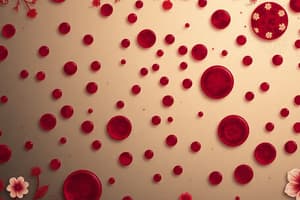Podcast
Questions and Answers
What is the primary cause of anemia of inflammation?
What is the primary cause of anemia of inflammation?
- Enhanced red blood cell production
- Decreased erythropoietin production
- Impaired iron utilization (correct)
- Increased erythrocyte lifespan
Which of the following lab results is typically seen in anemia of chronic disease?
Which of the following lab results is typically seen in anemia of chronic disease?
- Normal or low ferritin levels (correct)
- High serum iron levels
- Increased total iron-binding capacity (TIBC)
- Elevated transferrin saturation
What is the mechanism of anemia in chronic diseases such as infections or malignancies?
What is the mechanism of anemia in chronic diseases such as infections or malignancies?
- Cytokine-mediated suppression of erythropoiesis (correct)
- Enhanced iron absorption in the gut
- Hemolysis of red blood cells
- Decreased erythropoietin secretion
Which parameter is often used to differentiate between iron deficiency anemia and anemia of chronic disease?
Which parameter is often used to differentiate between iron deficiency anemia and anemia of chronic disease?
In anemia of inflammation, which of the following is most affected?
In anemia of inflammation, which of the following is most affected?
What effect does chronic disease have on iron metabolism in anemia of chronic disease?
What effect does chronic disease have on iron metabolism in anemia of chronic disease?
Which lab test result may be misleading in distinguishing between iron deficiency anemia and anemia of inflammation?
Which lab test result may be misleading in distinguishing between iron deficiency anemia and anemia of inflammation?
What is the characteristic feature of anemia of inflammation on peripheral blood smear examination?
What is the characteristic feature of anemia of inflammation on peripheral blood smear examination?
Which of the following is NOT a common symptom of anemia of chronic disease?
Which of the following is NOT a common symptom of anemia of chronic disease?
"Anemia of Inflammation" primarily affects:
"Anemia of Inflammation" primarily affects:
Which type of anemia is characterized by cells that are smaller than usual?
Which type of anemia is characterized by cells that are smaller than usual?
What is the typical MCV range for macrocytic anemia?
What is the typical MCV range for macrocytic anemia?
Which condition is associated with defective DNA synthesis leading to macrocytic anemia?
Which condition is associated with defective DNA synthesis leading to macrocytic anemia?
What is the primary characteristic of normochromic anemia?
What is the primary characteristic of normochromic anemia?
Which of the following is NOT a common etiology of microcytic anemia?
Which of the following is NOT a common etiology of microcytic anemia?
In the context of anemia, what is the significance of a reticulocyte count in the initial evaluation?
In the context of anemia, what is the significance of a reticulocyte count in the initial evaluation?
If a patient presents with normocytic anemia, which part of the RBC indices should be analyzed to confirm this diagnosis?
If a patient presents with normocytic anemia, which part of the RBC indices should be analyzed to confirm this diagnosis?
'Hypochromic' in hypochromic anemia refers to:
'Hypochromic' in hypochromic anemia refers to:
'Normocytic' in normocytic anemia means:
'Normocytic' in normocytic anemia means:
'Macrocytic' in macrocytic anemia indicates:
'Macrocytic' in macrocytic anemia indicates:
Flashcards are hidden until you start studying
Study Notes
Hematopathology
- Classification of Hematopathology based on lineages:
- Erythrocyte disorders
- WBC disorders
- Hematopathology
- Plasma cell disorders
- Platelet disorders
Hematopoiesis
- Blood cell differentiation and lineages
- Stem cells play a role in hematopoietic and lymphoreticular diseases
Complete Blood Count (CBC)
- Definition: blood test that evaluates cells that circulate in blood
- Components:
- White Blood Cell (WBC) count with or without a differential
- Red Blood Cell (RBC) count
- Hemoglobin (Hgb or Hb)
- Hematocrit (Hct)
- RBC indices: MCV, MCH, MCHC, and RDW
- Platelet count with or without MPV and/or PDW
RBC Indices
- MCV: measures RBC size
- MCH: measures the amount of Hgb per cell
- MCHC: measures the concentration of Hgb in each RBC
- RDW: measures the variation in RBC size
- Descriptors:
- MCHC: normochromic, hypochromic, hyperchromic
- MCV: normocytic, microcytic, macrocytic
Anemia
- Causes:
- Decreased production
- Blood loss (hemorrhage)
- Increased destruction
- Types:
- Erythrocytosis/Polycythemia (too many cells)
- Anemia (too few cells)
- Disorders of decreased production:
- Lack of raw materials: Iron deficiency anemia, Anemia of chronic disease, Folate deficiency anemia, Vitamin B12 (cobalamin) deficiency anemia
- Enzyme defects: Glucose-6-Phosphate Dehydrogenase Deficiency, Pyruvate Kinase Deficiency
- Immune mediated: Rh disease of the newborn, Systemic Lupus Erythematosus
- Infections: Malaria and other parasitic infections
Iron Studies
- Iron panel tests:
- Ferritin: protein that stores iron
- Transferrin: protein that transports iron in the blood
- TIBC: total iron binding capacity
- Iron saturation %: calculated by dividing serum iron by TIBC and multiplying by 100
Anemia Characterization
- Based on morphology:
- Microcytic: cells are smaller than usual
- Hypochromic: less than normal amount of hemoglobin
- Normocytic: cells are normal sized
- Normochromic: normal hemoglobin concentration
- Macrocytic: cells are larger than usual
Laboratory Tests
- Reticulocyte count: measures the number of immature RBCs
- Hemoglobin electrophoresis: measures the different types of hemoglobin
- Iron studies: measures iron levels and binding capacity
- Blood smear: evaluates morphology of RBCs
- Osmotic fragility test: measures the ability of RBCs to withstand changes in osmolality
Studying That Suits You
Use AI to generate personalized quizzes and flashcards to suit your learning preferences.




